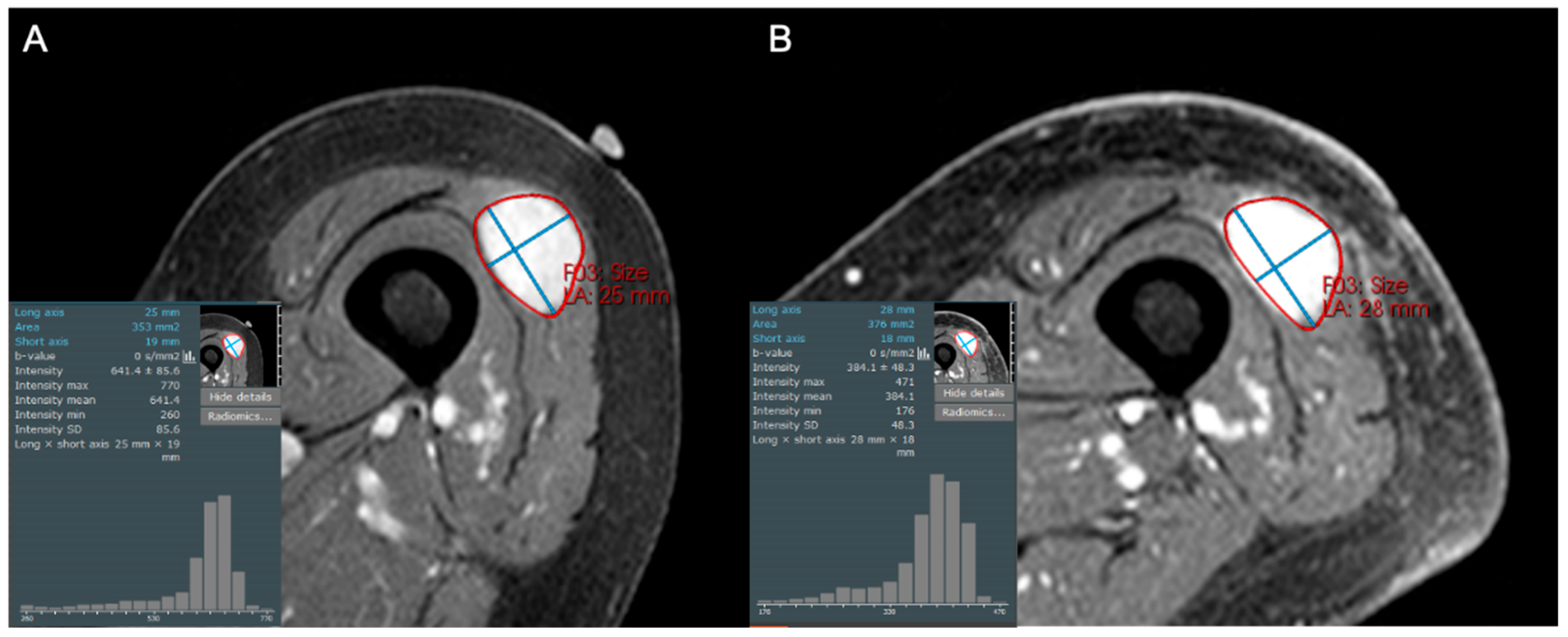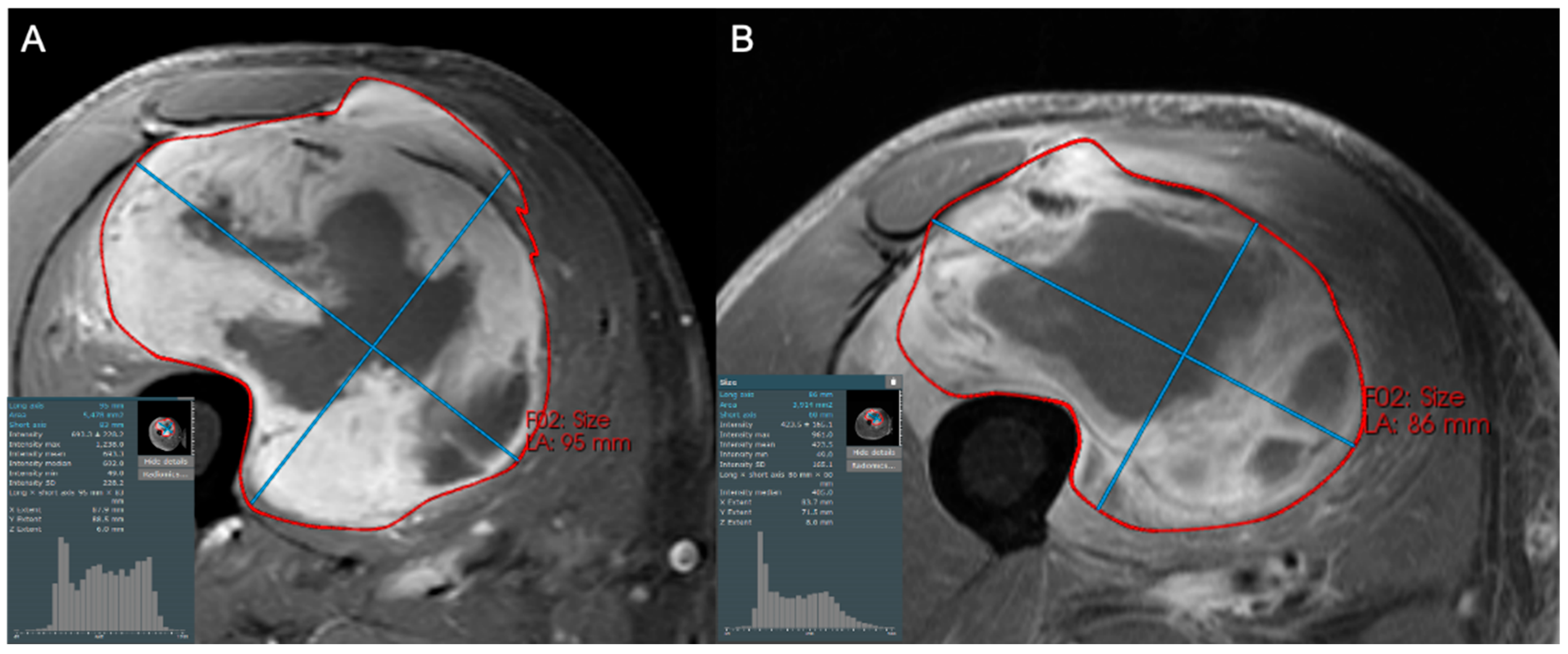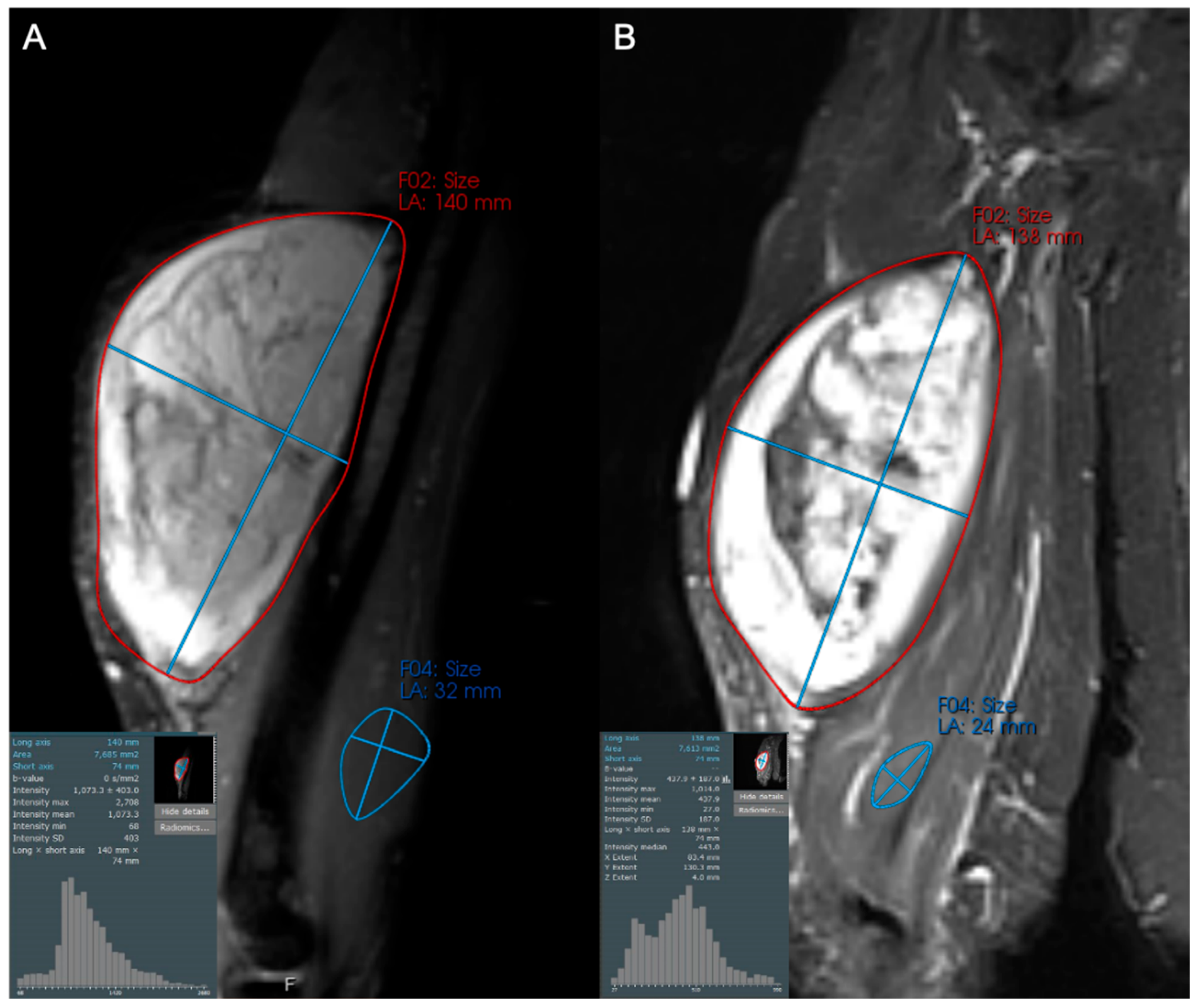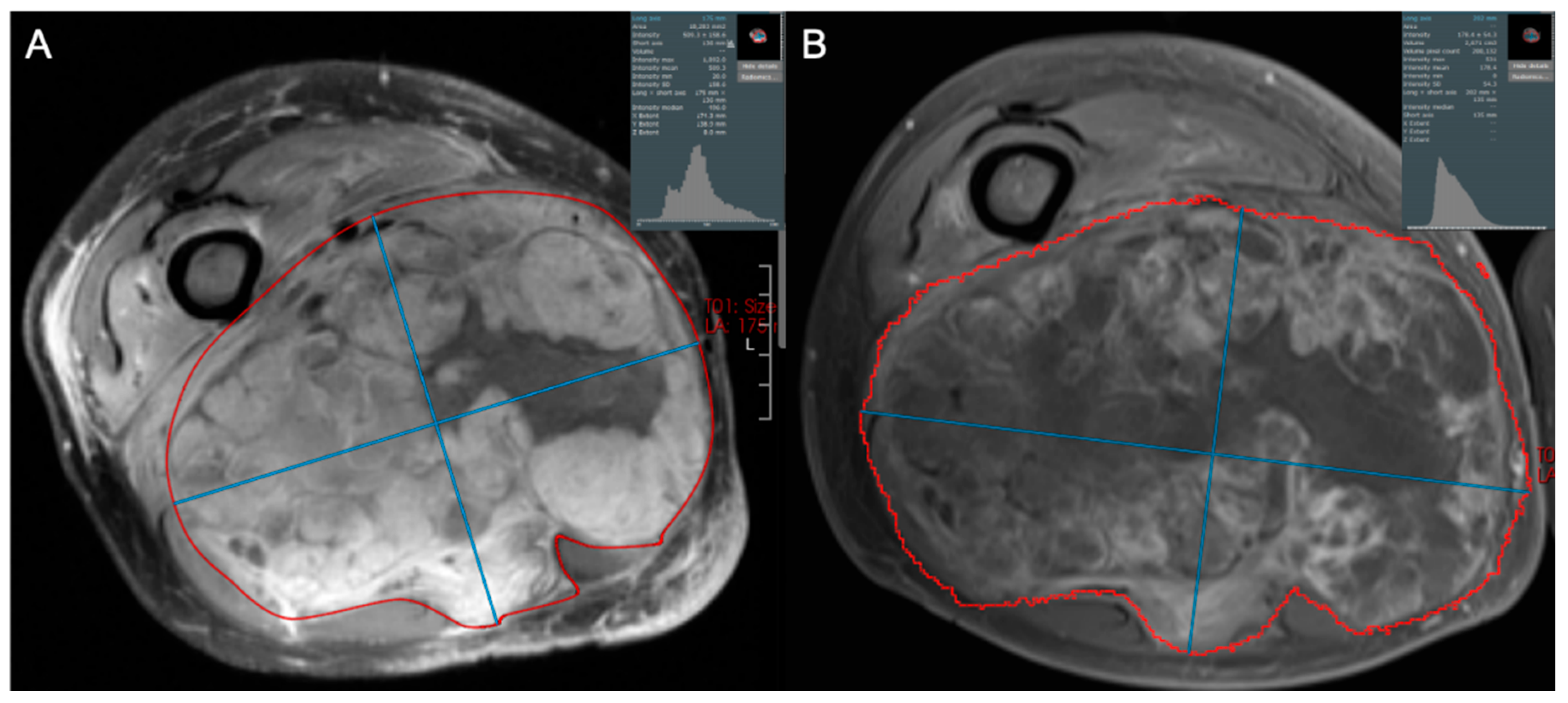Radiomics in Soft Tissue Sarcoma: Toward Precision Imaging in Oncology
Simple Summary
Abstract
1. Introduction
2. Radiomics in Initial Diagnosis of Soft Tissue Sarcomas
3. Grading, Prognostication, and Outcomes
4. Radiomics in Treatment Planning and Assessment of Treatment Response
5. Current Challenges
| Radiomic Feature (Type) | Definition of Feature | Significance to Sarcoma Imaging/Notes on Robustness |
|---|---|---|
| Tumor size/volume (shape) | 3D volume of segmented region of interest, representing whole tumor | Predictor for soft tissue sarcoma recurrence and metastasis, but influenced by segmentation protocols [51,60] |
| Mean intensity (first-order) | Average voxel intensity (histogram) within region of interest | Used in CT/MRI sarcoma models for grade and prognosis, but affected by image acquisition techniques [61] |
| Skewness/Kurtosis (first-order) | Asymmetry of intensity distribution (skewness) and peakedness relative to normal (kurtosis) | Can help predict local recurrence and metastases; sensitive to many variables including outliers and binning [60] |
| GLCM Contrast (texture) | Intensity contrast between voxel and its neighbor, measuring local heterogeneity | Can predict tumor heterogeneity and thus histologic grade and aggressiveness, but sensitive to many variables [62,63] |
| Peritumoral textural summary (region-based) | Summary of features capturing characteristics of peritumoral zone | Can describe peritumoral microenvironment and improve models that predict grade of sarcomas; sensitive to segmentation variability [37] |
| GLCM Entropy/Dissimilarity (texture) | Texture entropy/dissimilarity—measures of heterogeneity | Higher values are related to high grade and more aggressive sarcomas; these features can vary with binning [63,64,65] |
6. Discussion and Future Perspectives
7. Conclusions
Author Contributions
Funding
Conflicts of Interest
References
- Noebauer-Huhmann, I.M.; Weber, M.-A.; Lalam, R.K.; Trattnig, S.; Bohndorf, K.; Vanhoenacker, F.; Tagliafico, A.; van Rijswijk, C.; Vilanova, J.C.; Afonso, P.D.; et al. Soft Tissue Tumors in Adults: ESSR-Approved Guidelines for Diagnostic Imaging. Semin. Musculoskelet. Radiol. 2015, 19, 475–482. [Google Scholar] [CrossRef] [PubMed]
- Garner, H.W.; Wessell, D.E.; Lenchik, L.; Ahlawat, S.; Baker, J.C.; Banks, J.; Demertzis, J.L.; Moon, B.S.; Pierce, J.L.; Scott, J.A.; et al. ACR Appropriateness Criteria® Soft Tissue Masses: 2022 Update. J. Am. Coll. Radiol. 2023, 20, S234–S245. [Google Scholar] [CrossRef] [PubMed]
- Cho, E.B.; Lee, S.K.; Kim, J.-Y.; Kim, Y. Synovial Sarcoma in the Extremity: Diversity of Imaging Features for Diagnosis and Prognosis. Cancers 2023, 15, 4860. [Google Scholar] [CrossRef] [PubMed]
- Craig, W.D.; Fanburg-Smith, J.C.; Henry, L.R.; Guerrero, R.; Barton, J.H. Fat-containing Lesions of the Retroperitoneum: Radiologic-Pathologic Correlation. RadioGraphics 2009, 29, 261–290. [Google Scholar] [CrossRef]
- Li, L.; Kaon, W.; Viswanathan, V.S.; Kosaraju, V.K.; Kosmas, C.; Devita, R.; Abboud, S.; Madabhushi, A.; Mangla, A. Radiomics of MRI scans enables differentiation of benign from malignant soft tissue sarcoma. J. Clin. Oncol. 2022, 40, 11565. [Google Scholar] [CrossRef]
- Zhao, F.; Ahlawat, S.; Farahani, S.J.; Weber, K.L.; Montgomery, E.A.; Carrino, J.A.; Fayad, L.M. Can MR imaging be used to predict tumor grade in soft-tissue sarcoma? Radiology 2014, 272, 192–201. [Google Scholar] [CrossRef]
- Panicek, D.M.; Gatsonis, C.; Rosenthal, D.I.; Seeger, L.L.; Huvos, A.G.; Moore, S.G.; Caudry, D.J.; Palmer, W.E.; McNeil, B.J. CT and MR imaging in the local staging of primary malignant musculoskeletal neoplasms: Report of the Radiology Diagnostic Oncology Group. Radiology 1997, 202, 237–246. [Google Scholar] [CrossRef]
- Sinha, S.; Peach, A.H.S. Diagnosis and management of soft tissue sarcoma. BMJ 2010, 341, c7170. [Google Scholar] [CrossRef]
- Bruno, F.; Arrigoni, F.; Mariani, S.; Splendiani, A.; Di Cesare, E.; Masciocchi, C.; Barile, A. Advanced magnetic resonance imaging (MRI) of soft tissue tumors: Techniques and applications. La Radiol. Medica 2019, 124, 243–252. [Google Scholar] [CrossRef]
- Ahlawat, S.; Fritz, J.; Morris, C.D.; Fayad, L.M. Magnetic resonance imaging biomarkers in musculoskeletal soft tissue tumors: Review of conventional features and focus on nonmorphologic imaging. J. Magn. Reson. Imaging 2019, 50, 11–27. [Google Scholar] [CrossRef]
- Zhang, Y.; Zhao, H.; Liu, Y.; Zeng, M.; Zhang, J.; Hao, D. Diagnostic Performance of Dynamic Contrast-Enhanced MRI and 18F-FDG PET/CT for Evaluation of Soft Tissue Tumors and Correlation with Pathology Parameters. Acad. Radiol. 2022, 29, 1842–1851. [Google Scholar] [CrossRef] [PubMed]
- Gillies, R.J.; Kinahan, P.E.; Hricak, H. Radiomics: Images Are More than Pictures, They Are Data. Radiology 2016, 278, 563–577. [Google Scholar] [CrossRef] [PubMed]
- Lambin, P.; Rios-Velazquez, E.; Leijenaar, R.; Carvalho, S.; van Stiphout, R.G.; Granton, P.; Zegers, C.M.; Gillies, R.; Boellard, R.; Dekker, A.; et al. Radiomics: Extracting more information from medical images using advanced feature analysis. Eur. J. Cancer 2012, 48, 441–446. [Google Scholar] [CrossRef] [PubMed]
- Aerts, H.J.W.L.; Velazquez, E.R.; Leijenaar, R.T.H.; Parmar, C.; Grossmann, P.; Carvalho, S.; Bussink, J.; Monshouwer, R.; Haibe-Kains, B.; Rietveld, D.; et al. Decoding tumour phenotype by noninvasive imaging using a quantitative radiomics approach. Nat. Commun. 2014, 5, 4006. [Google Scholar] [CrossRef]
- Shur, J.D.; Doran, S.J.; Kumar, S.; ap Dafydd, D.; Downey, K.; O’Connor, J.P.B.; Papanikolaou, N.; Messiou, C.; Koh, D.-M.; Orton, M.R. Radiomics in Oncology: A Practical Guide. RadioGraphics 2021, 41, 1717–1732. [Google Scholar] [CrossRef]
- Scalas, G.; Parmeggiani, A.; Martella, C.; Tuzzato, G.; Bianchi, G.; Facchini, G.; Clinca, R.; Spinnato, P. Magnetic resonance imaging of soft tissue sarcoma: Features related to prognosis. Eur. J. Orthop. Surg. Traumatol. 2021, 31, 1567–1575. [Google Scholar] [CrossRef]
- Zhu, N.; Meng, X.; Wang, Z.; Hu, Y.; Zhao, T.; Fan, H.; Niu, F.; Han, J. Radiomics in Diagnosis, Grading, and Treatment Response Assessment of Soft Tissue Sarcomas: A Systematic Review and Meta-analysis. Acad. Radiol. 2024, 31, 3982–3992. [Google Scholar] [CrossRef]
- Virarkar, M.; Diab, R.; Palmquist, S.; Bassett, R., Jr.; Bhosale, P. Diagnostic Performance of MRI to Differentiate Uterine Leiomyosarcoma from Benign Leiomyoma: A Meta-Analysis. J. Belg. Soc. Radiol. 2020, 104, 69. [Google Scholar] [CrossRef]
- Lakhman, Y.; Veeraraghavan, H.; Chaim, J.; Feier, D.; Goldman, D.A.; Moskowitz, C.S.; Nougaret, S.; Sosa, R.E.; Vargas, H.A.; Soslow, R.A.; et al. Differentiation of Uterine Leiomyosarcoma from Atypical Leiomyoma: Diagnostic Accuracy of Qualitative MR Imaging Features and Feasibility of Texture Analysis. Eur. Radiol. 2017, 27, 2903–2915. [Google Scholar] [CrossRef]
- Nakagawa, M.; Nakaura, T.; Namimoto, T.; Iyama, Y.; Kidoh, M.; Hirata, K.; Nagayama, Y.; Oda, S.; Sakamoto, F.; Shiraishi, S.; et al. A multiparametric MRI-based machine learning to distinguish between uterine sarcoma and benign leiomyoma: Comparison with 18F-FDG PET/CT. Clin. Radiol. 2019, 74, e161–e167. [Google Scholar] [CrossRef]
- Xie, H.; Hu, J.; Zhang, X.; Ma, S.; Liu, Y.; Wang, X. Preliminary utilization of radiomics in differentiating uterine sarcoma from atypical leiomyoma: Comparison on diagnostic efficacy of MRI features and radiomic features. Eur. J. Radiol. 2019, 115, 39–45. [Google Scholar] [CrossRef] [PubMed]
- Roller, L.A.; Wan, Q.; Liu, X.; Qin, L.; Chapel, D.; Burk, K.S.; Guo, Y.; Shinagare, A.B. MRI, clinical, and radiomic models for differentiation of uterine leiomyosarcoma and leiomyoma. Abdom. Radiol. 2024, 49, 1522–1533. [Google Scholar] [CrossRef] [PubMed]
- Santoro, M.; Zybin, V.; Coada, C.A.; Mantovani, G.; Paolani, G.; Di Stanislao, M.; Modolon, C.; Di Costanzo, S.; Lebovici, A.; Ravegnini, G.; et al. Machine Learning Applied to Pre-Operative Computed-Tomography-Based Radiomic Features Can Accurately Differentiate Uterine Leiomyoma from Leiomyosarcoma: A Pilot Study. Cancers 2024, 16, 1570. [Google Scholar] [CrossRef]
- Wang, T.; Gong, J.; Li, Q.; Chu, C.; Shen, W.; Peng, W.; Gu, Y.; Li, W. A combined radiomics and clinical variables model for prediction of malignancy in T2 hyperintense uterine mesenchymal tumors on MRI. Eur. Radiol. 2021, 31, 6125–6135. [Google Scholar] [CrossRef]
- Tirotta, F.; Schut, A.W.; Wemmers, D.; Klein, S.; Visser, J.J.; Hanff, D.F.; Olsthoorn, M.; Grünhagen, D.J.; van Leenders, G.; van Houdt, W.J.; et al. Evaluation of Diagnostic Accuracy of Preoperative CT-Based Radiomics in Primary Retroperitoneal Sarcoma. Ann. Surg. Oncol. 2025, 32, 7799–7807. [Google Scholar] [CrossRef]
- Timbergen, M.J.M.; Starmans, M.P.A.; Padmos, G.A.; Grünhagen, D.J.; van Leenders, G.J.L.H.; Hanff, D.F.; Verhoef, C.; Niessen, W.J.; Sleijfer, S.; Klein, S.; et al. Differential diagnosis and mutation stratification of desmoid-type fibromatosis on MRI using radiomics. Eur. J. Radiol. 2020, 131, 109266. [Google Scholar] [CrossRef]
- Ristow, I.; Madesta, F.; Well, L.; Shenas, F.; Wright, F.; Molwitz, I.; Farschtschi, S.; Bannas, P.; Adam, G.; Mautner, V.F.; et al. Evaluation of magnetic resonance imaging-based radiomics characteristics for differentiation of benign and malignant peripheral nerve sheath tumors in neurofibromatosis type 1. Neuro-Oncology 2022, 24, 1790–1798. [Google Scholar] [CrossRef]
- Wang, C.; Zhang, Z.; Dou, Y.; Liu, Y.; Chen, B.; Liu, Q.; Wang, S. Development of clinical and magnetic resonance imaging-based radiomics nomograms for the differentiation of nodular fasciitis from soft tissue sarcoma. Acta Radiol. 2023, 64, 2578–2589. [Google Scholar] [CrossRef]
- Benhabib, H.; Brandenberger, D.; Lajkosz, K.; Demicco, E.G.; Tsoi, K.M.; Wunder, J.S.; Ferguson, P.C.; Griffin, A.M.; Naraghi, A.; Haider, M.A.; et al. MRI Radiomics Analysis in the Diagnostic Differentiation of Malignant Soft Tissue Myxoid Sarcomas From Benign Soft Tissue Musculoskeletal Myxomas. J. Magn. Reson. Imaging 2025, 61, 2630–2641. [Google Scholar] [CrossRef]
- Coindre, J.-M. Grading of Soft Tissue Sarcomas: Review and Update. Arch. Pathol. Lab. Med. 2006, 130, 1448–1453. [Google Scholar] [CrossRef]
- Machado, I.; Cruz, J.; Righi, A.; Gambarotti, M.; Ferrari, C.; Ruengwanichayakun, P.; Giner, F.; Rausell, N.; Lavernia, J.; Sugita, S.; et al. Ki-67 immunoexpression and radiological assessment of necrosis improves accuracy of conventional and modified core biopsy systems in predicting the final grade assigned to adult-soft tissue sarcomas. An international collaborative study. Pathol. Res. Pract. 2021, 225, 153562. [Google Scholar] [CrossRef] [PubMed]
- Schneider, N.; Strauss, D.C.; Smith, M.J.; Miah, A.B.; Zaidi, S.; Benson, C.; van Houdt, W.J.; Jones, R.L.; Hayes, A.J.; Fisher, C.; et al. The Adequacy of Core Biopsy in the Assessment of Smooth Muscle Neoplasms of Soft Tissues: Implications for Treatment and Prognosis. Am. J. Surg. Pathol. 2017, 41, 923–931. [Google Scholar] [CrossRef] [PubMed]
- Young, R.; Snow, H.; Hendry, S.; Mitchell, C.; Slavin, J.; Schlicht, S.; Na, L.; Hofman, M.S.; Gyorki, D.E. Correlation between percutaneous biopsy and final histopathology for retroperitoneal sarcoma: A single-centre study. ANZ J. Surg. 2020, 90, 497–502. [Google Scholar] [CrossRef] [PubMed]
- Xu, W.; Hao, D.; Hou, F.; Zhang, D.; Wang, H. Soft Tissue Sarcoma: Preoperative MRI-Based Radiomics and Machine Learning May Be Accurate Predictors of Histopathologic Grade. Am. J. Roentgenol. 2020, 215, 963–969. [Google Scholar] [CrossRef]
- Schmitz, F.; Voigtländer, H.; Jang, H.; Schlemmer, H.P.; Kauczor, H.U.; Sedaghat, S. Predicting the Malignancy Grade of Soft Tissue Sarcomas on MRI Using Conventional Image Reading and Radiomics. Diagnostics 2024, 14, 2220. [Google Scholar] [CrossRef]
- Wang, B.; Guo, H.; Zhang, M.; Huang, Y.; Duan, L.; Huang, C.; Xu, J.; Wang, H. Prediction of soft tissue sarcoma grading using intratumoral habitats and a peritumoral radiomics nomogram: A multi-center preliminary study. Front. Oncol. 2024, 14, 1433196. [Google Scholar] [CrossRef]
- Zhang, L.; Yang, Y.; Wang, T.; Chen, X.; Tang, M.; Deng, J.; Cai, Z.; Cui, W. Intratumoral and peritumoral MRI-based radiomics prediction of histopathological grade in soft tissue sarcomas: A two-center study. Cancer Imaging 2023, 23, 103. [Google Scholar] [CrossRef]
- Schmitz, F.; Sedaghat, S. Diagnostic Value of Magnetic Resonance Imaging Radiomics and Machine-learning in Grading Soft Tissue Sarcoma: A Mini-review on the Current State. Acad. Radiol. 2025, 32, 311–315. [Google Scholar] [CrossRef]
- Schmitz, F.; Voigtländer, H.; Strauss, D.; Schlemmer, H.-P.; Kauczor, H.-U.; Jang, H.; Sedaghat, S. Differentiating low- and high-proliferative soft tissue sarcomas using conventional imaging features and radiomics on MRI. BMC Cancer 2024, 24, 1589. [Google Scholar] [CrossRef]
- Tian, L.; Zhang, D.; Bao, S.; Nie, P.; Hao, D.; Liu, Y.; Zhang, J.; Wang, H. Radiomics-based machine-learning method for prediction of distant metastasis from soft-tissue sarcomas. Clin. Radiol. 2021, 76, e119–e158. [Google Scholar] [CrossRef]
- Hu, Y.; Wang, X.; Yue, Z.; Wang, H.; Wang, Y.; Luo, Y.; Jiang, W. Radiomics of multi-parametric MRI for the prediction of lung metastasis in soft-tissue sarcoma: A feasibility study. Cancer Imaging 2024, 24, 119. [Google Scholar] [CrossRef] [PubMed]
- Cheung, E.Y.W.; Chu, E.S. MO21-1 MRI radiomics to predict recurrence and prognosis in patients with soft-tissue sarcoma. Ann. Oncol. 2023, 34, S1409. [Google Scholar] [CrossRef]
- Yu, Y.; Guo, H.; Zhang, M.; Hou, F.; Yang, S.; Huang, C.; Duan, L.; Wang, H. Multi-institutional validation of a radiomics signature for identification of postoperative progression of soft tissue sarcoma. Cancer Imaging 2024, 24, 59. [Google Scholar] [CrossRef] [PubMed]
- Wang, T.; Wang, L.; Zhong, H.; Zong, Y.; Hou, F.; Wang, H.; Zhou, R.; Gao, S.; Shi, X.; Yang, J.; et al. MRI-derived radiomics model for predicting intratumoral tertiary lymphoid structures in soft tissue sarcoma. Insights Imaging 2025, 16, 201. [Google Scholar] [CrossRef]
- Italiano, A.; Bessede, A.; Pulido, M.; Bompas, E.; Piperno-Neumann, S.; Chevreau, C.; Penel, N.; Bertucci, F.; Toulmonde, M.; Bellera, C.; et al. Pembrolizumab in soft-tissue sarcomas with tertiary lymphoid structures: A phase 2 PEMBROSARC trial cohort. Nat. Med. 2022, 28, 1199–1206. [Google Scholar] [CrossRef]
- Crombé, A.; Périer, C.; Kind, M.; De Senneville, B.D.; Le Loarer, F.; Italiano, A.; Buy, X.; Saut, O. T2-based MRI Delta-radiomics improve response prediction in soft-tissue sarcomas treated by neoadjuvant chemotherapy. J. Magn. Reson. Imaging 2019, 50, 497–510. [Google Scholar] [CrossRef]
- Fields, B.K.K.; Demirjian, N.L.; Cen, S.Y.; Varghese, B.A.; Hwang, D.H.; Lei, X.; Desai, B.; Duddalwar, V.; Matcuk, G.R., Jr. Predicting Soft Tissue Sarcoma Response to Neoadjuvant Chemotherapy Using an MRI-Based Delta-Radiomics Approach. Mol. Imaging Biol. 2023, 25, 776–787. [Google Scholar] [CrossRef]
- Subhawong, T.K.; Feister, K.; Sweet, K.; Alperin, N.; Kwon, D.; Rosenberg, A.; Trent, J.; Wilky, B.A. MRI Volumetrics and Image Texture Analysis in Assessing Systemic Treatment Response in Extra-Abdominal Desmoid Fibromatosis. Radiol. Imaging Cancer 2021, 3, e210016. [Google Scholar] [CrossRef]
- Singer, A.D.; Pattany, P.M.; Fayad, L.M.; Tresley, J.; Subhawong, T.K. Volumetric segmentation of ADC maps and utility of standard deviation as measure of tumor heterogeneity in soft tissue tumors. Clin. Imaging 2016, 40, 386–391. [Google Scholar] [CrossRef]
- Valenzuela, R.; Duran-Sierra, E.; Canjirathinkal, M.; Amini, B.; Torres, K.; Benjamin, R.; Ma, J.; Wang, W.; Hwang, K.; Stafford, R.; et al. Radiomics by Quantitative Diffusion-weighted MRI for Predicting Response in Patients with Extremity Soft-tissue Undifferentiated Pleomorphic Sarcoma. J. Radiol. Oncol. 2024, 8, 064–071. [Google Scholar] [CrossRef]
- Gitto, S.; Cuocolo, R.; Huisman, M.; Messina, C.; Albano, D.; Omoumi, P.; Kotter, E.; Maas, M.; Van Ooijen, P.; Sconfienza, L.M. CT and MRI radiomics of bone and soft-tissue sarcomas: An updated systematic review of reproducibility and validation strategies. Insights Imaging 2024, 15, 54. [Google Scholar] [CrossRef]
- Zwanenburg, A.; Vallières, M.; Abdalah, M.A.; Aerts, H.; Andrearczyk, V.; Apte, A.; Ashrafinia, S.; Bakas, S.; Beukinga, R.J.; Boellaard, R.; et al. The Image Biomarker Standardization Initiative: Standardized Quantitative Radiomics for High-Throughput Image-based Phenotyping. Radiology 2020, 295, 328–338. [Google Scholar] [CrossRef] [PubMed]
- Traverso, A.; Wee, L.; Dekker, A.; Gillies, R. Repeatability and Reproducibility of Radiomic Features: A Systematic Review. Int. J. Radiat. Oncol. Biol. Phys. 2018, 102, 1143–1158. [Google Scholar] [CrossRef] [PubMed]
- Shafiq-Ul-Hassan, M.; Zhang, G.G.; Latifi, K.; Ullah, G.; Hunt, D.C.; Balagurunathan, Y.; Abdalah, M.A.; Schabath, M.B.; Goldgof, D.G.; Mackin, D.; et al. Intrinsic dependencies of CT radiomic features on voxel size and number of gray levels. Med. Phys. 2017, 44, 1050–1062. [Google Scholar] [CrossRef] [PubMed]
- He, H.; Garcia, E.A. Learning from Imbalanced Data. IEEE Trans. Knowl. Data Eng. 2009, 21, 1263–1284. [Google Scholar] [CrossRef]
- Xu, S.; Ying, Y.; Hu, Q.; Li, X.; Li, Y.; Xiong, H.; Chen, Y.; Ye, Q.; Li, X.; Liu, Y.; et al. Fusion model integrating multi-sequence MRI radiomics and habitat imaging for predicting pathological complete response in breast cancer treated with neoadjuvant therapy. Cancer Imaging 2025, 25, 108. [Google Scholar] [CrossRef]
- Cai, C.; Xiao, J.-F.; Cai, R.; Ou, D.; Wang, Y.-W.; Chen, J.-Y.; Xu, H.-P. Longitudinal dynamic MRI radiomic models for early prediction of prognosis in locally advanced cervical cancer treated with concurrent chemoradiotherapy. Radiat. Oncol. 2024, 19, 181. [Google Scholar] [CrossRef]
- Zhou, X.; Yu, Y.; Feng, Y.; Ding, G.; Liu, P.; Liu, L.; Ren, W.; Zhu, Y.; Cao, W. Attention mechanism based multi-sequence MRI fusion improves prediction of response to neoadjuvant chemoradiotherapy in locally advanced rectal cancer. Radiat. Oncol. 2023, 18, 175. [Google Scholar] [CrossRef]
- Liu, S.; Lv, Y.; Duan, L.; Wang, C.; Wang, H.; Hu, S.; Abbar, B.; Xu, J. Development and validation of multi-sequence magnetic resonance imaging radiomics models for predicting tumor response to radiotherapy in locally advanced non-small cell lung cancer. J. Thorac. Dis. 2025, 17, 1684–1697. [Google Scholar] [CrossRef]
- Casale, R.; Varriano, G.; Santone, A.; Messina, C.; Casale, C.; Gitto, S.; Sconfienza, L.M.; Bali, M.A.; Brunese, L. Predicting risk of metastases and recurrence in soft-tissue sarcomas via Radiomics and Formal Methods. JAMIA Open 2023, 6, ooad025. [Google Scholar] [CrossRef]
- Chen, S.; Li, N.; Tang, Y.; Chen, B.; Fang, H.; Qi, S.; Lu, N.; Yang, Y.; Song, Y.; Liu, Y.; et al. Radiomics Analysis of Fat-Saturated T2-Weighted MRI Sequences for the Prediction of Prognosis in Soft Tissue Sarcoma of the Extremities and Trunk Treated With Neoadjuvant Radiotherapy. Front. Oncol. 2021, 11, 710649. [Google Scholar] [CrossRef] [PubMed]
- Lee, S.E.; Jung, J.-Y.; Nam, Y.; Lee, S.-Y.; Park, H.; Shin, S.-H.; Chung, Y.-G.; Jung, C.-K. Radiomics of diffusion-weighted MRI compared to conventional measurement of apparent diffusion-coefficient for differentiation between benign and malignant soft tissue tumors. Sci. Rep. 2021, 11, 15276. [Google Scholar] [CrossRef] [PubMed]
- Annovazzi, A.; Ferraresi, V.; Covello, R.; Ascione, A.; Vari, S.; Petrongari, M.G.; Baldi, J.; Biagini, R.; Sciuto, R. Prognostic Value of Pre-Treatment [18F]FDG PET/CT Texture Analysis in Undifferentiated Soft-Tissue Sarcoma. J. Clin. Med. 2022, 12, 279. [Google Scholar] [CrossRef] [PubMed]
- Corino, V.D.A.; Montin, E.; Messina, A.; Casali, P.G.; Gronchi, A.; Marchianò, A.; Mainardi, L.T. Radiomic analysis of soft tissues sarcomas can distinguish intermediate from high-grade lesions. J. Magn. Reason. Imaging 2018, 47, 829–840. [Google Scholar] [CrossRef]
- De Angelis, R.; Casale, R.; Coquelet, N.; Ikhlef, S.; Mokhtari, A.; Simoni, P.; Bali, M.A. The impact of radiomics in the management of soft tissue sarcoma. Discov. Oncol. 2024, 15, 62. [Google Scholar] [CrossRef]
- Ma, J.; He, Y.; Li, F.; Han, L.; You, C.; Wang, B. Segment anything in medical images. Nat. Commun. 2024, 15, 654. [Google Scholar] [CrossRef]
- Mirghaderi, P.; Valizadeh, P.; Haseli, S.; Kim, H.S.; Azhideh, A.; Nyflot, M.J.; Schaub, S.K.; Chalian, M. Performance of Radiomics and Deep Learning Models in Predicting Distant Metastases in Soft Tissue Sarcomas: A Systematic Review and Meta-analysis. Acad. Radiol. 2025, 32, 6773–6795. [Google Scholar] [CrossRef]
- Wankhade, S.; Vigneshwari, S. A novel hybrid deep learning method for early detection of lung cancer using neural networks. Healthc. Anal. 2023, 3, 100195. [Google Scholar] [CrossRef]
- Nardone, V.; Reginelli, A.; Rubini, D.; Gagliardi, F.; Del Tufo, S.; Belfiore, M.P.; Boldrini, L.; Desideri, I.; Cappabianca, S. Delta radiomics: An updated systematic review. Radiol. Med. 2024, 129, 1197–1214. [Google Scholar] [CrossRef]






Disclaimer/Publisher’s Note: The statements, opinions and data contained in all publications are solely those of the individual author(s) and contributor(s) and not of MDPI and/or the editor(s). MDPI and/or the editor(s) disclaim responsibility for any injury to people or property resulting from any ideas, methods, instructions or products referred to in the content. |
© 2025 by the authors. Licensee MDPI, Basel, Switzerland. This article is an open access article distributed under the terms and conditions of the Creative Commons Attribution (CC BY) license (https://creativecommons.org/licenses/by/4.0/).
Share and Cite
Shah, A.; Alessandrino, F.; Palmerini, E.; Ortiz Requena, D.; Crawford, B.; Subhawong, T.K. Radiomics in Soft Tissue Sarcoma: Toward Precision Imaging in Oncology. Cancers 2025, 17, 3661. https://doi.org/10.3390/cancers17223661
Shah A, Alessandrino F, Palmerini E, Ortiz Requena D, Crawford B, Subhawong TK. Radiomics in Soft Tissue Sarcoma: Toward Precision Imaging in Oncology. Cancers. 2025; 17(22):3661. https://doi.org/10.3390/cancers17223661
Chicago/Turabian StyleShah, Anuj, Francesco Alessandrino, Emanuela Palmerini, Domenika Ortiz Requena, Brooke Crawford, and Ty K. Subhawong. 2025. "Radiomics in Soft Tissue Sarcoma: Toward Precision Imaging in Oncology" Cancers 17, no. 22: 3661. https://doi.org/10.3390/cancers17223661
APA StyleShah, A., Alessandrino, F., Palmerini, E., Ortiz Requena, D., Crawford, B., & Subhawong, T. K. (2025). Radiomics in Soft Tissue Sarcoma: Toward Precision Imaging in Oncology. Cancers, 17(22), 3661. https://doi.org/10.3390/cancers17223661





